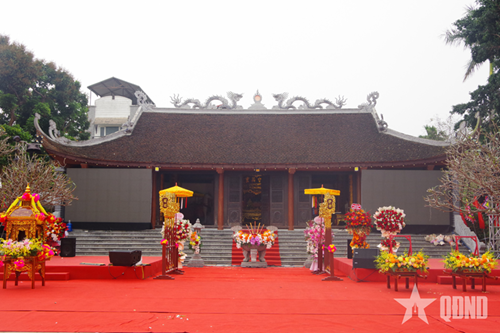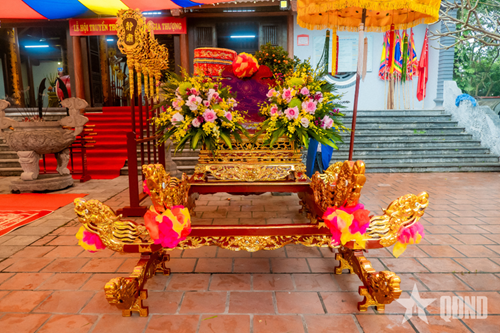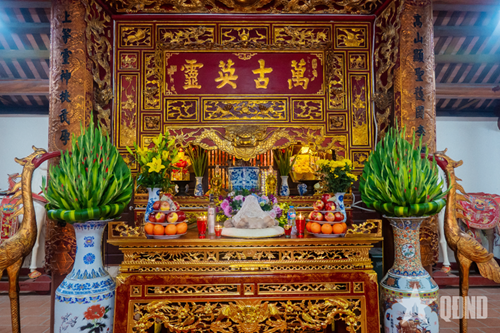Traces of an ancient communal house by Duong River
Gia Thuong Communal House was originally built by local residents on the alluvial bank outside the dyke along the Duong River. It now lies within Ngoc Thuy ward, Long Bien district, Hanoi. The house has long been a sacred and communal gathering place for people living in this area.
    |
 |
|
An view of Gia Thuong Communal House, featuring traditional architectural design reconstructed on the original foundation after 2002 |
The house is dedicated to five tutelary deities, notably Linh Lang Dai Vuong and Cao Son Dai Vuong, both of whom hold special significance in the spiritual beliefs of the people of Thang Long Imperial Citadel. Linh Lang, son of King Ly Thanh Tong, was honored for his efforts in defending the country against the Song invaders and is chiefly worshipped at Voi Phuc Temple in Ngoc Khanh ward, Ba Dinh district. Cao Son, a general under the legendary Tan Vien Son Thanh (Tan Vien Mountain Saint), is worshipped at Kim Lien Communal House in Dong Da district as a symbol of mountain strength in the myth of Son Tinh and Thuy Tinh.
In addition, Gia Thuong Communal House venerates Giang Khau Dai Vuong (Guardian Deity of the River Mouth) and two deified historical figures from the Ly Dynasty: Minh Tru Dai Vuong and Minh Khiet Dai Vuong, who were later immortalized in local folk beliefs.
Although original documents recording the house’s construction have not survived, material evidence such as the ancient palanquin and a centuries-old banyan tree suggest the communal house dates back around 200-300 years.
    |
 |
|
The lacquered and gilded palanquin set, a 19th-century artifact currently preserved at Gia Thuong Communal House |
The house has endured multiple instances of destruction due to natural disasters and wars. In particular, during the early stages of the resistance war against the French colonialists in 1947, French aircraft bombed the Gia Thuong area, reducing the communal house to ashes. Only the foundation and a few artifacts were salvaged by the villagers.
It was not until 2002 that the communal house was reconstructed on its original foundation, thanks to contributions from both local authorities and residents. The new structure was designed in the traditional three-compartment, two lean-to style with four curved roofs, blending modern faux-wood painted materials with traditional wooden beams, lim-wood rafters, and tiled roofs. The rear sanctuary houses an altar and five sets of lacquered and gilded long ngai (royal thrones for deities).
Today, the house preserves many valuable artifacts, including worship thrones, horizontal lacquered boards, parallel sentences, porcelain incense burners, six ceremonial swords, and especially a lacquered and gilded palanquin set dating back to the 19th century.
Preserving and promoting cultural heritage
To this day, Gia Thuong Communal House continues to retain its sacred atmosphere and the village’s long-standing customs. The site has become an important place for younger generations to learn about their cultural roots and to carry forward the nation’s traditional values.
    |
 |
|
The worship space inside Gia Thuong Communal House |
Every year, the communal house comes alive during the traditional Gia Thuong Village Festival, which draws large crowds of local residents. In addition to solemn spiritual rituals praying for peace, prosperity, and favorable weather, villagers also immerse themselves in the festive atmosphere through unique activities such as the water-fetching ceremony, folk games, and performances of hat van and hat chau van (traditional spiritual singing).
In recognition of its historical and cultural significance, Gia Thuong Communal House was officially designated a municipal-level Historical and Cultural Relic under Decision No.1168/QD-UBND, as part of the listing of 17 cultural relics in Hanoi, issued by the Hanoi People's Committee on February 28, 2025.
    |
 |
|
The traditional festival of Gia Thuong Communal House, held annually on the seventh and eighth day of Lunar March |
This recognition is a source of pride for the local community and a reaffirmation of the site’s outstanding cultural and spiritual value — a heritage that deserves continued preservation and promotion for future generations.
Translated by Chung Anh